


#Flic flac spider series#
The spider creates its dwelling with its pedipalps (feelers) and bristles, forming long, vertical tubes out of sand and silk. Using a series of rapid, acrobatic flic-flac movements of its legs similar to those used by gymnasts, the spider is able to actively propel itself off the ground, allowing it to move both down and uphill, even at a 40 percent incline. This behavior is different than other huntsman spiders, such as Carparachne aureoflava from the Namib Desert, which uses passive cartwheeling as a form of locomotion. The Moroccan flic-flac spider is nocturnal and is known to feed on moths before sunrise. It spends the hot desert days in its cool burrow in the sand protected from the sun and predators. But since it uses so much energy, the manoeuvre is a last resort, called on only to escape predators. This leaping arachnid is the only spider known to move by means of flic-flac jump.Dr Rechenberg The move doubles the spider’s speed, to two metres per second from one metre per second. It can jump 6.6 feet per second, enabling it to move two times faster than it can when simply walking. Scientists have discovered a new species of gymnastic spider. Cebrennus rechenbergi, one of the ten most fascinating species in 2015, can cartwheel! It belongs to the Sparassidae family of spiders that are synonymous with speed and often known as huntsmen, Nicknamed “flicflac” by Dr Peter Jager of Senckenberg Research Institute, who identified the spider, it performs acrobatic flips in the air which resemble cartwheels. He has studied the area for three decades.ĭiscovery of Cebrennus rechenbergi and its ability to perform cartwheels was profiled in the journal Zootaxa.A nocturnal spider native to the Erg Chebbi Desert in Morocco has an acrobatic solution to escape danger. He told the press he started crying when he saw the cartwheels performed for the first time. The huntsman spider species called the Moroccan flic-flac spider (Cebrennus rechenbergi) has a unique way of moving. Rechenberg captured the first samples of the insects before he first observed the animal carry out the unusual behavior. The somersaulting robot is named after the Berber word for spider, tabacha.Īmazingly, the tiny animals are also able to create structures to shade itself in the desert. In unusual conditions like collapsed buildings or mines, the action could help small robots avoid obstacles. It is able to either walk or tumble, depending on which offers the most efficient method of transportation in varying environments. Tabbot is designed to test the nature-inspired technology that could, one day, be used on robotic craft in the depths of the ocean or the surface of Mars. A similar tumbleweed style spider has been previously described, the golden rolling spider, but this spider is restricted in its agility since it is only able to roll down hills. Rechenberg was so impressed by the ability of the spider to perform this act he designed a new robot, able to perform cartwheels. Although the spiders regularly acted out the behavior in the desert, the act was rarely performed in a laboratory setting. It has the ability to cartwheel to be able to escape danger. Golden wheel spiders, related to the flic-flac, can cartwheel downhill, but the newly-discovered species can perform the move while traveling upward, as well. The Flic-Flac Spider This spider is a native of the Erg Chebbi desert in southeastern Morocco. Diminutella: As its name suggests, this is one of the tiniest of these giant spiders. A robot was actually built to mimic this spider’s movements. It lives in the Erg Chebbi desert on the edge of the Sahara. So far, the new species has only been seen in the Erg Chebbi region where Rechenberg first encountered the organisms. It’s found in Morocco and is also called the Moroccan flic-flac spider. The biological model for the BionicWheelBot is the flic-flac spider (cebrennus rechenbergi). These are known for their hunting abilities. Peter Jäger, a taxonomist at the Senckenberg Research Institute and Natural History Museum in Frankfurt, Germany, who identified the spider, has nicknamed it the flic-flac for the maneuver its leap. The spider researcher conducted a careful analysis of the creatures.Īfter confirmation of Rechenberg's discovery, the species was classified as a new form of Cebrennus, or huntsman spiders. Rechenberg brought specimens to Peter Jäger, of the Senckenberg Research Institute in Frankfurt, Germany. When performing this strange behavior, the tiny creatures can travel up to 6.6 feet per second.


 0 kommentar(er)
0 kommentar(er)
